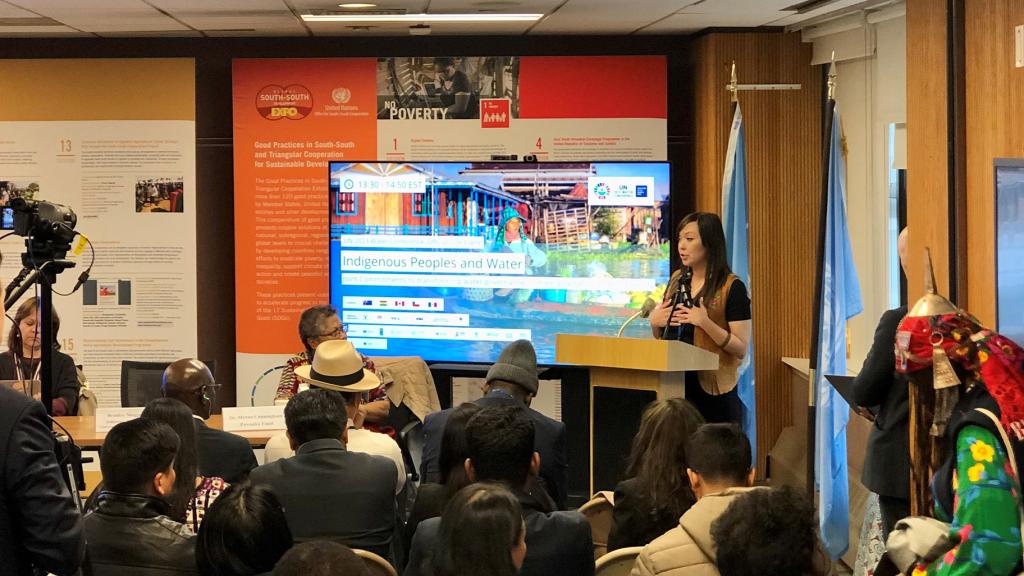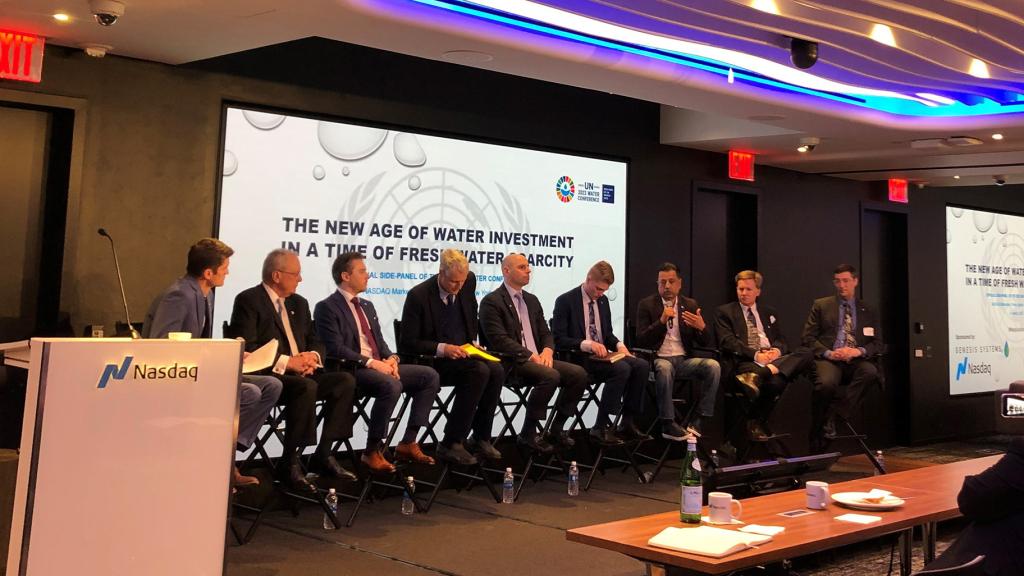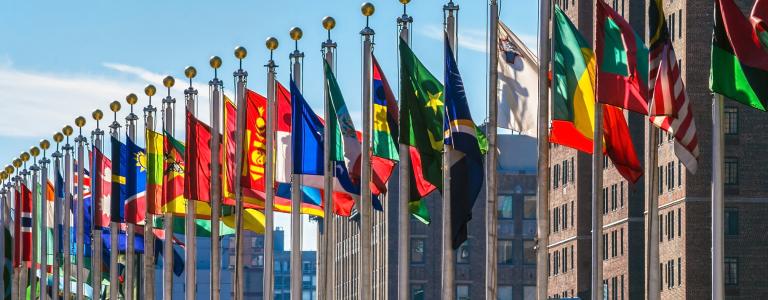From the UN 2023 Water Conference to the HLPF: Time for a radical shift in perspective on water
Water issues are taking centre stage at the High-Level Political Forum on Sustainable Development (HLPF) this week in New York, as the international community takes stock of the progress made toward five of the 17 Sustainable Development Goals (SDGs)—including SDG 6 on clean water and sanitation. Coming on the heels of a landmark UN 2023 Water Conference held in March, what should governments, practitioners, scientists, and civil society keep in mind as we use the HLPF to review where we are on SDG 6 and where we are heading?
In this article, I look back on what the UN 2023 Water Conference showed us about the state of our water challenges and needs, as well as our perspective on water. As we approach the halfway mark of the 2030 Agenda for Sustainable Development, I propose that now is the moment for radical change.
The UN 2023 Water Conference: Taking stock of a half-century in water
The UN 2023 Water Conference, held March 22 to 24, 2023, was the first conference at the United Nations centred on water issues since 1977. The conference produced the Water Action Agenda—a compilation of more than 700 voluntary commitments by UN member states and stakeholders to accelerate progress toward SDG 6.
The world has changed dramatically over the past 46 years: the global population has doubled, cities have grown, new technologies have emerged, and new contaminants are being found in our water.
These are physical changes. But have our mindsets changed as well? Water is vital to our lives. We cannot survive without water longer than a few days. Yet instead of valuing it accordingly, we continue to exploit it well beyond sustainable levels. It is used in the production of everything we use and consume, from food to clothing to technology. The more we want to produce and disseminate, the more water we extract. The public discourse around water is extremely important because it shapes our attitudes and forms our understanding of water challenges and solutions.
At the 1977 conference in Mar del Plata, Argentina, governments discussed water as a resource vital to social and economic development and placed a strong emphasis on "the conservation and rational use of water resources." At the 2023 conference in New York City, the "sound management of water resources" was again an important subject for governments. However, the context of these conversations has changed as the impacts of climate change are increasingly being felt. Last year alone, human-caused climate change was linked to major droughts in Europe, the United States, and China, sparking concerns over impending water scarcity; meanwhile, Pakistan experienced devastating floods.
After 46 years, it is clear that we can no longer continue with a status quo approach to economic development. The tougher our environmental challenges become, the more radical our actions need to be to address them. This includes, first and foremost, a radical change in mindset around water and economic development.
Making sure all voices are heard in valuing water
One of the main messages expressed during the March conference was that "the world must radically change the way it understands, values, and manages water." A crucial part of that change is ensuring all voices are heard in the decision-making processes. The UN 2023 Water Conference took the positive step of featuring voices of youth and Indigenous Peoples—an approach that could help trigger a radical perspective shift in valuing water—and one that subsequent conversations must build on.
For example, the official event "Indigenous-led Conservation for the Health of Water Ecosystems in Canada and the World"—co-organized by IISD—shone a light on Indigenous leadership in conservation and the importance of Indigenous knowledge and values in water stewardship.
The event highlighted the examples of the Seal River Watershed and the Magpie River while touching on the role of partnerships and embracing diverse worldviews to protect nature and adapt to our changing water cycle. The Seal River Watershed is a pristine watershed spanning over 50,000 square kilometres in northern Manitoba, Canada, that the Indigenous traditional land stewards want to conserve permanently. The Magpie River in Québec was the first river to be granted legal personhood status in Canada.
Lawyers from the International Observatory on Nature's Rights, which was one of the event partners, are working to attribute legal personalities to natural areas and shift our mindsets. Under this approach, nature can no longer to be treated as an "object" or a "resource" to be exploited but must instead be treated as a "subject of rights" that requires respect and protection for future generations.
Another event organized by the UN Educational, Scientific and Cultural Organization (UNESCO) and partners focused on Indigenous knowledge and water governance. Indigenous stewards from Australia, Canada, Chad, and Latin America spoke about Indigenous knowledge as a driver for water solutions. In a packed room of passionate Indigenous speakers, we heard from Hindou Oumarou Ibrahim, an Indigenous activist from Chad.
"We have four decades: decade of water, decade of ecosystem restoration, decade of language, decade of ocean," Ibrahim said. "Let us have all of [these decades] together in collaboration and let us have a mechanism where Indigenous people can participate across all [of] these decades." This intervention and others reinforced how an Indigenous holistic perspective and focus on nature can guide us to change our understanding, valuation, and management of water, as well as all interconnected systems.

The finance challenge and definition of the "water sector"
To understand water challenges and solutions from a different perspective, I made my way to Times Square for the event "The New Age of Water Investing in a Time of Water Scarcity" at the NASDAQ office.
The event brought to the fore another crucial aspect of the water conversation, one that hinged on experiences of water scarcity and the challenges in finding, financing, and executing solutions.
Jay Heller, the Head of Capital Markets at NASDAQ, pointed to the significant underfinancing seen in the water sector. For instance, when considering the exchange traded funds (ETFs) industry as an indicator of the capital raised for businesses, there are approximately 9,000 ETFs listed and formatted worldwide with USD 20 trillion in assets under management. Out of those, there are only seven ETFs earmarked for water, with only USD 4 billion in assets under management.
Beyond the limited number of ETFs for water, we need to consider our definition of the water sector. Does this encompass only dams, pumps, and pipelines, or does it require a broader definition, one that goes beyond our understanding from nearly 5 decades ago?

The conversation included a call to broaden our perspective. Zac Goldsmith, the United Kingdom's then Minister for Overseas Territories, Commonwealth, Energy, Climate and Environment at the Foreign, Commonwealth & Development Office, emphasized the crucial role of nature, especially in light of how environmental governance treats different issue areas.
"In the ideal world, you would not have created a climate COP, a biodiversity COP, a desertification COP, and all these different things—and treat water as if it is something entirely separate because all these things are absolutely inextricably linked," he said, referring to the different Conferences of the Parties held under various multilateral environmental agreements. "My proposal is we focus as much as possible on nature… When you back nature, you get a whole range of benefits beyond what you initially were trying to achieve," Goldsmith emphasized.
For water, nature-based solutions can help stabilize shores, recharge aquifers, and slow water runoff. These solutions can also support biodiversity, clean the air, and mitigate climate change, to give a few examples.
Looking ahead: New perspectives on water and foregrounding the role of nature
Throughout the conversations I heard in New York, the recurring theme was that nature needs to be at the centre of solutions. This message resonated across stakeholder groups—from those stewarding traditional lands to those fighting for legal rights of nature to those working on mainstreaming nature in British policy.
Heading into the in-depth review of SDG 6 this July at the HLPF in New York, these reflections indicate there is a need to radically redefine our understanding of the value of water and water investments and to reconcile the way we live with nature.
Now it is the time for the global community to tune into this new mindset, elevate the work of Indigenous land stewards, educate the broader public on these issues, and, particularly, advance nature's rights. This will be a stepping stone to transformative water action.

You might also be interested in
IISD Annual Report 2022–2023
At IISD, we’ve been working for more than three decades to create a world where people and the planet thrive. As the climate crisis unfolds on our doorsteps and irreversible tipping points loom, our team has been focused more than ever on impact.
Imagining an Ethical Place for AI in Environmental Governance: Lessons from water management in Guyana
The topic of artificial intelligence (AI) has been ubiquitous following the release of Open AI's ChatGPT language processing model. What are some of the considerations which dominate the current debate around AI and what do they mean for environmental governance and policy?
UN Plastics Treaty: After rocky start, 170 nations agree to draw up draft agreement
Last week's crunch talks were on the 'brink of chaos', but on Friday 170 nations agreed to draw up an initial first draft of a global plastic pollution treaty by November.
New global chemicals, waste framework to include textiles: IISD
Textiles will come under a new global framework for the sustainable management of chemicals and waste that will be decided at the fifth International Conference on Chemicals Management (ICCM5) in Bonn in September this year.
